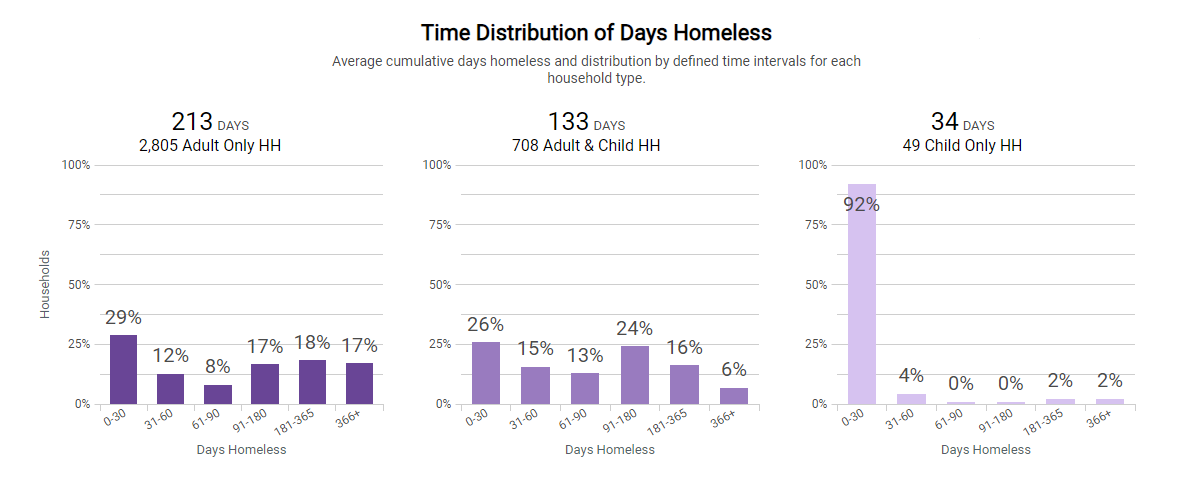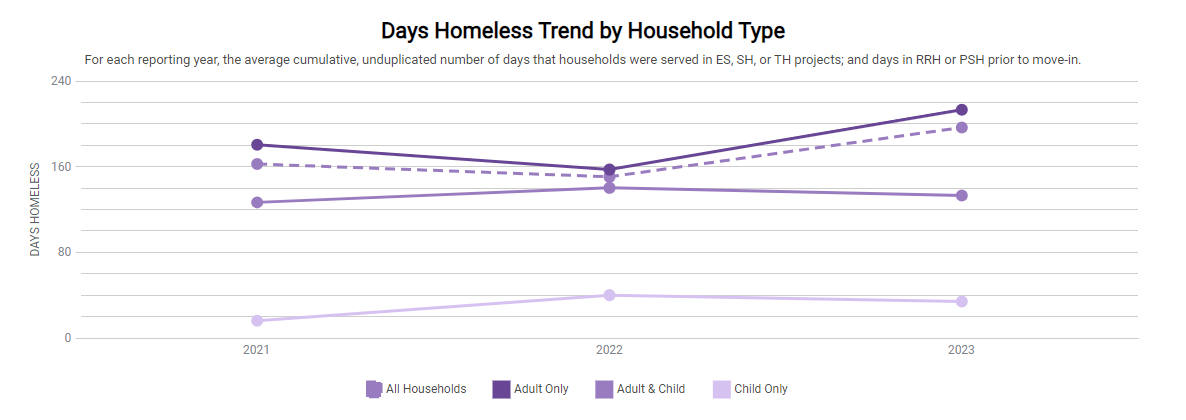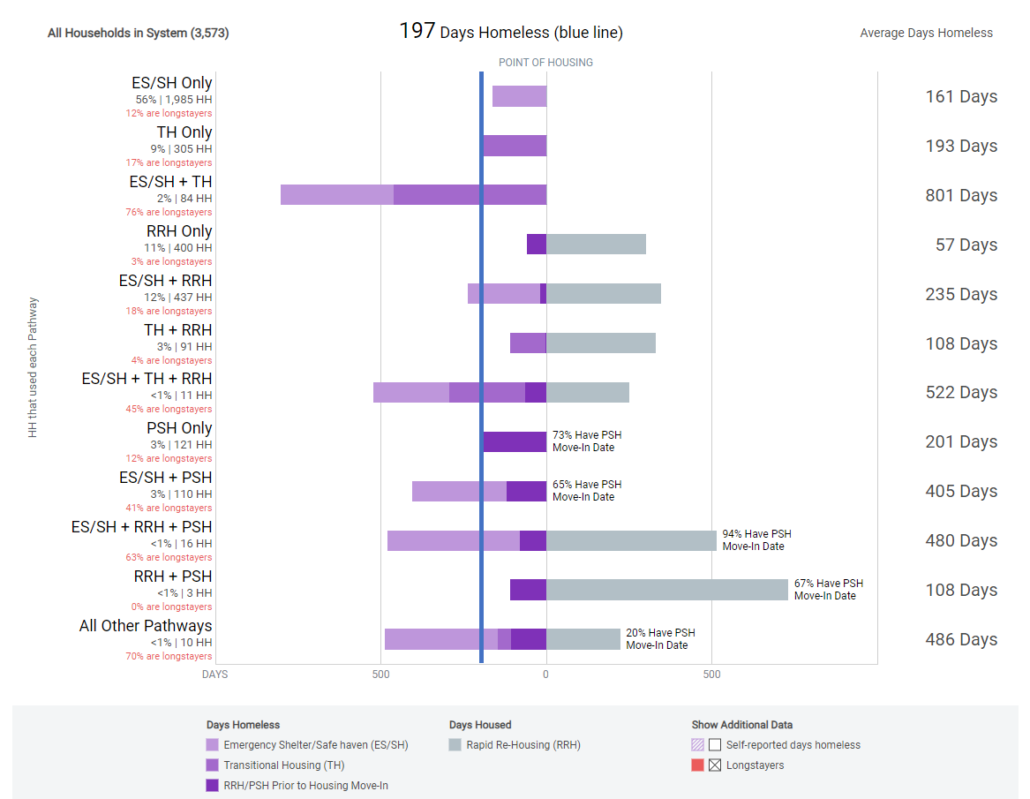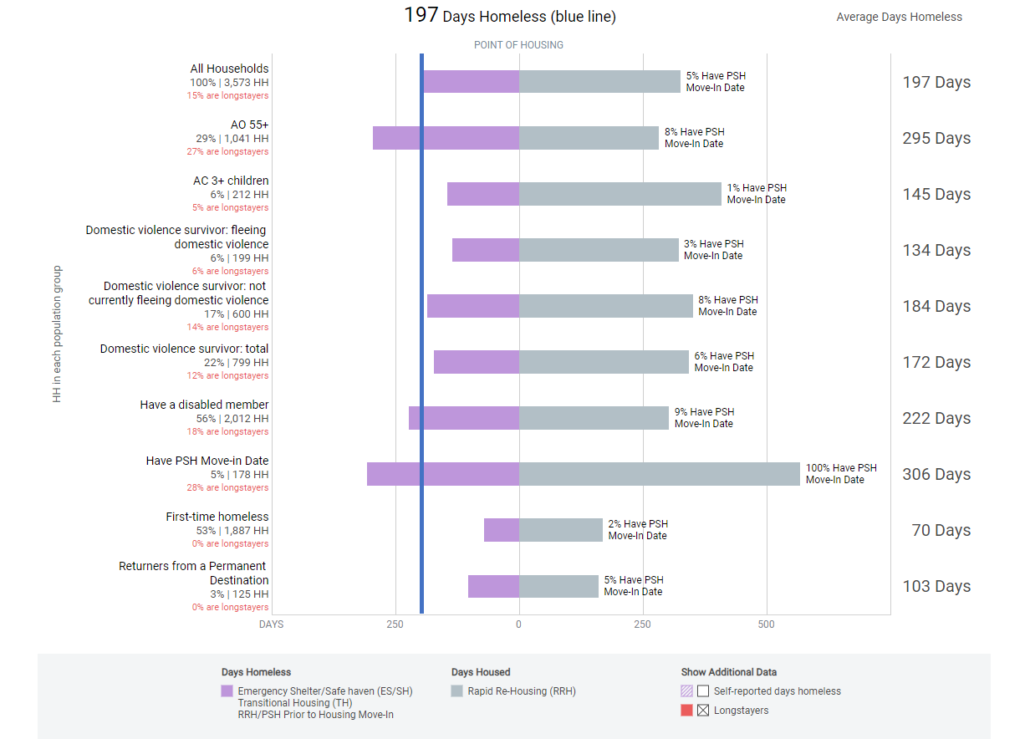Leveraging Stella P to Enhance Homeless Services Systems: Decreasing Days Homeless
Mary Ann Priester
Senior Management Analyst
Mecklenburg County Community Support Services
Stella, developed by the Department of Housing and Urban Development (HUD), serves as an analytical and strategic tool for Continuums of Care (CoCs) to examine the dynamics of their homeless services system performance. The Stella Performance Module (Stella P) visualizes a homeless system’s performance using the CoC’s Longitudinal System Analysis (LSA) data. Stella P empowers communities to develop and monitor strategies to improve system performance. This blog is the third installment in a series of blogs examining Charlotte-Mecklenburg’s latest LSA data utilizing the Stella P Module.
This blog provides an overview of days homeless, local performance on this metric, and highlights opportunities for performance improvement within the Charlotte-Mecklenburg homeless services system.
STELLA P
Stella P is used to visualize a CoC’s Longitudinal System Analysis (LSA) data. It consists of five sections: Dashboard, Days Homeless, Exits, Returns, and Demographics.
Dashboard: Provides an overview of the number of households and people served and a performance overview; trends over the past 3 years; and a system performance map.
Days Homeless, Exits, Returns: Reviews system level performance for number of days homeless, permanent housing exits from the homeless system, and returns to homelessness after exits to a permanent destination. Each measure can be examined by pathway (combination of projects types a household uses when moving through the homelessness system), population group, and race and ethnicity.
Demographics: Provides an overview of demographic characteristics for households and individuals served by household type and project type and a comparison of demographic characteristics by project type.
Previous blogs provided an overview of LSA data and the Stella P dashboard and system performance map and system exits. This blog focuses on days homeless.
DAYS HOMELESS
The Stella P Days Homeless module consists of four components: Days Homeless Overview, Days Homeless by Pathway, Days Homeless by Population Group, and Days Homeless by Race and Ethnicity. This blog will examine the first three. A future blog will focus on how Stella P can be used to assess system performance by race and ethnicity.
Days Homeless is the average cumulative number of days that households were enrolled in emergency shelter, transitional housing, and safe haven projects and those served in rapid rehousing and permanent supportive housing projects prior to moving into housing in HMIS. This metric captures continuous enrollment in these project types while homeless from October 1, 2012 to the end of the reporting period (in this case September 30, 2023). A break in homelessness is considered 7 days. Households that experienced less than seven days between enrollments in these project types during this period are considered not to have had a break in homelessness and so these periods of less than 7 days between enrollments are included in the overall count of days homeless for the household. It is important to note that this metric only tells us the length of time households were enrolled in these project types and considered homeless within the homeless services system. An exit from these projects could have been to permanent housing but it also could have been to a temporary or institutional situation.
The Day Homeless Overview page shows an overview of days homeless by household type, the time distribution of days homeless by household type, and trends in the number of days homeless in the previous three years. The Days Homeless by Pathway page shows days homeless by the combination of projects that a household was served in during their experience in the homeless services system. The Day Homeless by Population Group page shows the percentage and number of each population group and average and cumulative days homeless for each population group. Both the Days Homeless by Pathway and Days Homeless by Population Group pages can be used to drill down to specific household days homeless and the ability to examine data for people who are considered long stayers or people who have been enrolled in the homeless system for more than 365 days.
CHARLOTTE-MECKLENBURG DAYS HOMELESS
OVERVIEW
The Charlotte-Mecklenburg Days Homeless module shows that the average cumulative days homeless across all household types is 197 days. The average cumulative number of days homeless for adult only households is 213 days, the average cumulative number of days homeless for adult-child households is 133 days, and the average cumulative number of days homeless for child only households is 34 days. When reviewing the time distribution of days homeless, 29% of adult only households are homeless for 30 days or less while 17% are homeless on average for over a year. For adult-child households, 26% are homeless for 30 days or less and 6% are homeless on average for over a year. The majority of child only households are homeless on average for less than 30 days. Most child only households are being served by a youth shelter that often serves as respite or temporary shelter for children whose caregivers are working to stabilize, re-enter housing, or obtain shelter that can accommodate the entire family. When examining trends over time, since 2022 there has been a 40 day increase in the average number of days homeless for adult only households and a 7 day decrease in the average number of days homeless for adult-child households.
BY PATHWAY
The Charlotte-Mecklenburg Days Homeless by Pathway module shows the highest average number of days homeless is experienced by people who utilize the emergency shelter/ safe haven + transitional housing pathway with an average number of days homeless of 801 days. It is important to note that this may be by design as transitional housing programs can provide up to 24 months of temporary housing and services. For this pathway, on average households stayed 461 days in transitional housing and 360 days in emergency shelter/ safe haven. This pathway only consists of 84 households or 2% of households within the data set. The highest percentage of households utilized the emergency shelter/ safe haven only pathway consisting of 56% or 1,985 households. On average, households using this pathway had on average 161 days homeless. In the emergency shelter/ safe haven pathway, 12% are long stayers or people who have been enrolled in emergency shelter/ safe haven for more than 180 days.
How to read the chart: The left side of the chart shows the pathway name and the number and percentage of households that utilized that pathway. Purple represents days homeless prior to housing move-in and gray represents the number of days housed post move-in.
BY POPULATION TYPE
The Days Homeless by Population Group chart shows that of the population types featured, adult only households consisting of people 55 years of age or older have the highest number of average days homeless, 295 days. Twenty-seven percent of all households in this population group are considered long stayers, experiencing homelessness for longer than 180 days on average. Notably, households with a disabled household member (222 days) and households that have a member who is a domestic violence survivor but are not currently fleeing (184 days) also experience on average, higher numbers of days homeless. For households with a disabled family member, 18% are considered long stayers. For households that have a member who is a domestic violence survivor but are not currently fleeing, 14% are considered long stayers. Households that are experiencing homelessness for the first time experience homelessness for shorter periods of time with 70 days homeless on average. Fifty-three percent of households are experiencing homelessness for the first time.
How to read the chart: The left side of the chart shows the population group name and the number and percentage of households within that population. Purple represents days homeless prior to housing move-in and gray represents the number of days housed post move-in.
OPPORTUNITIES FOR IMPROVEMENT
Based upon the data provided in the Stella P Days Homeless module, targeting interventions to focus on long stayers who utilize the emergency shelter/ safe haven only pathway would have the greatest impact on the overall average days homeless across the system. Previous community research suggests that households that are long stayers in emergency shelter/ safe haven are typically single, older male adults who are disproportionately Black, African American, or African. They often have extremely low income, previous involvement with the criminal justice system, and report physical disabilities and chronic health conditions. As part of previous research, community stakeholders met to discuss the challenges they were seeing on the frontlines that may be contributing people staying long-term in shelter. They cited that often people need subsidized or public housing but waiting lists are long. People often need senior housing but there are insufficient senior housing resources in the community. In addition, criminal justice background or insufficient income results in challenges exiting shelter.
To address these challenges the stakeholder group suggested:
- Developing and expanding bridge housing options that can serve as an interim housing solution while people await the availability of subsidized or public housing.
- Exploring how Medicaid can be leveraged to support senior housing.
- Standardizing the use of reasonable accommodation waivers to ensure older adults with challenging backgrounds can access senior housing resources.
- Identifying flexible subsidies that can be used to pay subsidy for someone to live with a family member.
- Expanding supported employment and leveraging vocational rehab to facilitate increased income for long stayers in shelter.
- Partnering with the faith community to connect long stayers to their affordable and supportive housing projects.
- Developing a streamlined and effective way to partner with legal services and assist clients with expungement or removal from registries.
SO WHY DOES THIS MATTER?
Stella P facilitates the system analysis necessary to create actionable strategy to improve the local homeless services system. Stella P’s Days Homeless module provides important insights into which pathways could be targeted to decrease the length of time people experience homelessness in Charlotte-Mecklenburg and which populations may need additional resources and supports to facilitate their rapid exit from homelessness. These data also highlight important considerations as our community makes decisions about resource allocation and alignment to ensure homelessness is rare, brief, and non-recurring in Charlotte-Mecklenburg.






